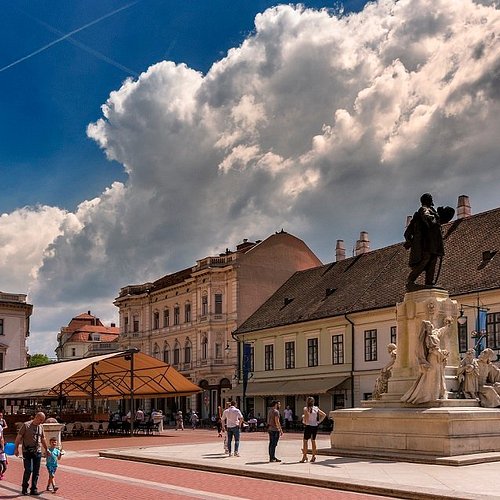Things to do in Csongrad County, Southern Great Plain: The Best Scenic Walking Areas
Discover the best top things to do in Csongrad County, Hungary including Klauzal Square, Rerrich Bela Square, Dugonics Square, Arad Martyrs Square, Szent Istvan Square.
Restaurants in Csongrad County
1. Klauzal Square
Overall Ratings
4.5 based on 24 reviews
The value preserving reconstruction of Kárász Street and Klauzál Square was granted with the Europe Nostra Award in 2004. The downtown palaces display the features of the different competing styles of the time, classicism, eclecticism and Art Nouveau. Their versatile, distinctive nature still creates a uniquely harmonic, well-balanced picture. While having a coffee, a cake or an ice-cream, we can have a look at the full-sized bronze statue of Lajos Kossuth, who made his last speech in Hungary from the balcony of the Kárász House, located on the other side of the square. On the eastern side of the square the harmonic building of the former Hotel Europe can be found as well as the New Zsótér House, which was built on the outer piles of the old castle, and where the operations of the reconstruction were directed from.
2. Rerrich Bela Square
Overall Ratings
4.5 based on 5 reviews
The square was named after the designer of the building complex in Dóm Square, the first remarkable figure in Hungarian landscape architecture, who created the gardens of the bishop’s palace and the university in a modern spirit relying on tradition. His ageless genius is also proved by the fact that in an online poll in 2007 the area around the Votive Church was voted the second most well-known architectural wonder in Hungary. There are two unique statues on the sides of the walk leading to the university lecture halls. The original gothic statue representing Saint George the Dragon Slayer by the Kolozsvári brothers is in Prague, the one standing here is a 20th century copy of the work made in 1373. On the opposite side there is a marble statue representing young men raising the dead butterfly of liberty high, commemorating the participants of the Revolution of 1956.
3. Dugonics Square
Overall Ratings
4.0 based on 20 reviews
The square was named after the piarist priest and teacher Andras Dugonics, the writer of the first Hungarian novel (Etelka, 1788). He was a language reformer, creator of numerous terms used in Hungarian mathematical language. His statue, which was erected from public donations, was the first statue in the public places of Szeged. The fountain opposite, inaugurated on the occasion of the centenary of the Great Flood in 1979. In the square the principal building of the University of Szeged, the early eclectic palace stands which was originally a secondary school. In front of the university we find the statue of Attila Jozsef, who was a student here between 1924 and 1925, and the statue of Albert Szent-Gyorgyi, the Nobel-prized scientist, who was named as an honorary doctor of the university on several times. At the corner of the square and Karasz Street stands the Unger-Mayer House, designed by Ede Magyar. The lead ladies dancing on the dome of the Art Nouveau palace.
Reviewed By MarriedAnd-Over-50 - Mission, Canada
We found a place to sit in the crowded shade area on one side of the fountain. Everyone wanted to be close to get a breeze from this lovely fountain. We enjoyed just looking at the configuration of the ever changing water flow. Just across the there is the Rector's Office of the University of Szeged, which used to be the polytechnic.
4. Arad Martyrs Square
Overall Ratings
4.0 based on 1 reviews
In the centre of the irregularly shaped square stands the nicely proportioned equestrian statue of Ferenc Rákóczi II, with the slogan of the War of Independence (Cum Deo pro patria et libertate), lead by him. We can find the memorial column of the Battle of Szőreg nearby, the marble plaque in front of it commemorates the thirteen generals executed in Arad. The Heroes’ Gate is the memorial place of the soldiers from Szeged who died in World War I. On the arch we can see the war theme frescos painted by Vilmos Aba-Novák. The memorial column of the Revolution of 1956 stands in the square too, reminding us of the fact that the events of October were launched by the movements of the students in Szeged. The square is surrounded by several buildings of the university, among which the most important is the building of the Faculty of Science and Informatics, the former piarist grammar school, where Gyula Juhász, one of the most well-known poets of Szeged, studied.





